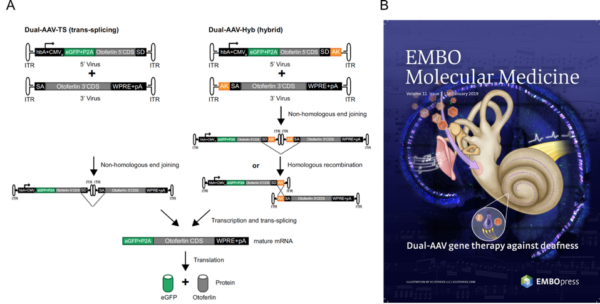Dual-AAV for large transgenes: treatment of deafness
AAV are very small viruses, and thus can package only a quite limited transgene capacity of about 5000 base pairs, of which about 500-1000 bp are necessary for transcriptional control elements like promoter, enhancer and polyadenylation sites. This is unfortunate as several promising gene therapy candidates in sensory systems like retina or inner ear exceed this size by far. Due to their relatively small size, good accessibility and partial protection from immune responses towards the vectors, sensory organs are probably the best suited targets for successful gene therapy approaches in the near future. The Otoferlin protein is defective in a fairly large percentage of people suffering from hereditary hearing loss. Otoferlin is crucially involved into the auditory signal transmission process from inner hair cells to spiral ganglion neurons of the inner ear. As Otoferlin´s cDNA comprises about 6000 bp, it is not suitable to be packaged into a single AAV vector. In addition, we and other groups have demonstrated that vectors with enhanced transgene capacity such as lentiviral or adenoviral vectors are not suitable for inner hair cell transduction.
Thus, in a collaboration with Ellen Reisinger (Dept. of Otorhinolaryngology, University Medicine Göttingen) we exploited a dual AAV vector system in Otoferlin -/- mice, where the 5´-part of Otoferlin was incorporated into one AAV vector, and the 3´-part of Otoferlin was incorporated into a second AAA vector. Appropriately positioned splice sites allowed for reconstitution of full length Otoferlin cDNA in transduced inner hair cells, and enabled a partial but still impressive recovery of auditory function (Al-Moyed et al, EMBO Mol Med 2019). Confirmation in large animal´s ears will now have to prove that the vector application strategy is feasible in humans.
Dual AAV gene therapy in deaf Otoferlin -/- mice
- A) The two approaches used (trans-splicing genomes and hybrid genomes) to generate the full length Otoferlin construct are schematically depicted
- B) A nice representation of the study by EMBO´s artists.
